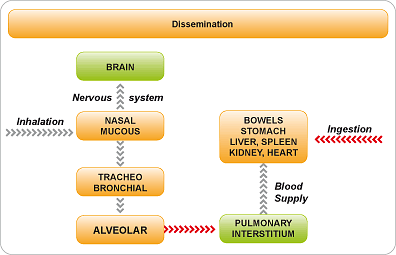
Dispersion routes.
Starting from the interstitium, particles can enter the bloodstream in addition to the lymphatic circulation. Particles then have the opportunity to reach organs (liver, lung, kidney,…) [G. OberdÖrster et al., Journal of Nanoscience and Nanotechnology 9 (2009) 4996-5007 / H.M. Braakhuis et al.,Particle and Fibre Toxicology 11 (2014)].
The migration through the bronchial epithelium from the alveoli into the lung interstitium near the pleura was found on animals 15 minutes after exposure. This translocation seems more important in large animals (dogs, monkeys) than in rats or mice.
Several studies have shown that translocation phenomenon depends of the nanoparticle size. Small particles are more subject to translocation and more easily distributable in organs. They aren’t phagocytose efficiently and they are capable of entering more quickly into the circulatory and/or lymphatic systems [E. Sadauskas et al., Chemistry Central Journal 3 (2009) / S.K. Balasubramanian et al., Biomaterials 34 (2013) 5439-5452 / C. Buzea et al., Biointerphases 2 (2007) 17-172].
The translocation phenomenon seems also to depend of the nanoparticle charged surface. Charged nanoparticles attract proteins, for example albumin, and reduce their translocation rate [H.S. Choi et al., Nature Biotechnology 28 (2010) 1300-1303 / H.M. Braakhuis et al. Particle and Fibre Toxicology 11 (2014)]. Attract proteins are allowed to form a crown around nanoparticles, thereby changing their absorption by alveolar macrophages.
From the nasal mucosa, particles could migrate by the axons of olfactory neurons to the central nervous system [J. Wang et al., Toxicology 254 (2008) 82-90 / Shi et al., Particle and Fibre Toxicology 10 (2013)].In rats, prolonged exposure (12 days) to manganese oxide particles causes a more important accumulation of manganese in the spinal bulb than in the lungs. The transposition of this result to humans must be balanced as the olfactory mucosa represents 5 % of the nasal mucosa in humans against 50 % in rats.


